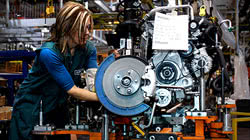Manufacturing
Will Lean Manufacturing Save an Ailing Industry?

It’s not often we think of Silicon Valley developers sharing ideas with executives from manufacturing companies, but over the last decade the two have become entwined in the search for increasingly efficient methods of operation. The interplay between agile principles developed in the software world and lean principles developed in the manufacturing world has created a cyclical relationship between the two whose hallmarks are ad hoc borrowing and constant reevaluation. As the software sector continues to flourish, the currently languid manufacturing sector will not only benefit from better software targeted at improving efficiency, but continue to follow the software industry’s lead in creating lean processes and incorporating customer feedback to iterate faster and offer better products to compete in the global market.
Before understanding just what manufacturing can learn from software, however, it’s important to provide an answer to the question: “Why does manufacturing matter?” As Robert Atkinson, President of the Information Technology and Innovation Foundation put it:
Manufacturing matters because it’s simply impossible to have a vibrant national economy without a healthy globally traded sector, and manufacturing is America’s most important traded sector. Traded sector enterprises, which comprise about one-third of the U.S. economy, are those that compete in international marketplaces and whose output is sold, at least in part, to non-residents of the nation.
…if a local grocer goes out of business, another will emerge to take its place to serve local demand, but if a traded sector enterprise such as a semiconductor, automobile, or aerospace manufacturer closes due to global competition, the business and jobs that take its place may well be located in another country.
Atkinson’s observation should make us all take a moment to reflect before patting ourselves on the back for rising employment numbers when, as he notes, we are essentially simply refilling necessary domestic jobs rather than focusing on fostering our disappearing traded sectors. How then can America expect to compete with nations like China whose economic policies, reduced civil liberties, and cheaper labor allow them to easily undercut any bids made by U.S. companies? The answer lies in the interplay of agile and lean methodologies, but understanding this dynamic means going back to its source.
In a 2010 article, Dan Woods posited that the agile software development model could benefit greatly by integrating lean manufacturing principles into its canon. To offer some context, here are the definitions of agile and lean that Woods provided:
In Agile methods, instead of building the whole product, you build the smallest possible useful part and give it to users, who tell you what is right and what is wrong.
In a Lean manufacturing system, the work is broken into a set of value streams triggered by demand signals. The output of one value stream leads to others. Value streams may be executed sequentially or in parallel as needed. Eventually, everything is combined into the product. The suppliers for materials needed are alerted through a system of just-in-time replenishment of parts and components called Kanban.
To sum up the message of Woods’ article, by waiting for demand to produce stock, products can be iterated using the agile method in the meantime thus creating a final product that reaches the market faster and is more representative of consumer needs. This trend has grown since 2010 as evidenced by Joe McKendrick’s recent article in which he notes that, “The two methodologies have a lot in common. And, as Dan observes, they are converging.”
I spoke with McKendrick about his views on the application of agile and lean principles to manufacturing and he told me, “As the software world has already learned, better quality and results are achieved when projects are developed in partnership with the end-users of the product. Also, “Agile practices in manufacturing would involve product designers, engineers and producers teaming up together and with end-user customers to deliver products and features on a continuous basis.”
He also pointed to the first principle of the Agile Manifesto which states that, “Our highest priority is to satisfy the customer through early and continuous delivery of valuable software,” only substitute ‘products’ for ‘software’ in the case of manufacturing.
The question then is why manufacturing should not borrow from software in the same way that software has borrowed from it? To some degree it already has as companies like Microsoft, Sage, NetSuite, and Plex all tout their respective ERP’s lean capabilities, not to mention the advent of 3D printing in recent years which has spurred companies like Daimler to begin investing in additive manufacturing systems to get concepts into production faster.
It’s no secret that the number of manufacturing jobs in the United States has, “been in a secular decline since the end of World War II,” and that the recession of 2008 did little to abate the hemorrhaging. The danger is that there aren’t just fewer manufacturing jobs in America due to tough economic times–manufacturing jobs are being systematically replaced by software development, engineering, and necessary corporate positions like HR, accounting, and sales. It’s ironic that Forbes’ Jacqueline Smith recently quoted CareerBuilder CEO Matt Ferguson in saying that, “You also see growth in production-related jobs as U.S. manufacturing rallies after experiencing significant losses during the recession,” while leaving manufacturing jobs out of the very same article: The Top Jobs for 2013. Maybe that’s what Ferguson meant by “production-related”–that as long as American companies are manufacturing somewhere there will still be office jobs housed in the U.S. Meanwhile the sector currently experiencing the most growth–software development–rides high as companies, “[compete] to get to market first with innovations that will create new revenue streams.” Though it may seem like America is finally bouncing back, returning our manufacturing sector to its former glory requires a sea change, one that many believe will come by applying the same principles that have made our software development sector thrive.
Want to learn more about lean manufacturing or other trends in the industry? Visit the Business-Software.com manufacturing software resource center for all of our exclusive content on industry news, product reviews and expert tips. Or compare top manufacturing solutions by downloading one of our free manufacturing software reports.






